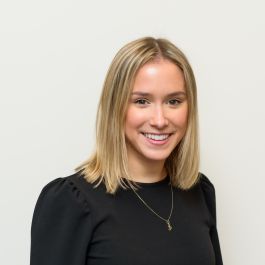Team culture can be a bit of a catch-all term.
It can mean the shared mission of a team, or the unique ways a team works and communicates. Or, it can speak to the unspoken team rule to wrap up the week by noon on Fridays to play video games.
Though a strong team culture can mean a lot of different things, there are common attributes that are found repeatedly: clear communication and respect.
Team culture — no matter how you define it — has a big impact on the mental health of employees. And working somewhere that prioritizes emotional and psychological well-being is at the top of the wish list for 92 percent of workers, according to the American Psychological Association’s 2023 Work in America Survey.
Built In found five Chicago tech leaders who were eager to share what a great team culture looks like at their company.
MoLo Solutions is a third-party logistics company that connects shippers with carriers to move freight.
Describe your company culture in one word. What made you pick that word? Provide a specific, real-life example of how that word exemplifies your team and culture.
One word to describe our company culture: connected. At MoLo, “connected” goes far beyond logistics — it’s about how we support each other, collaborate across teams and build relationships that make work more meaningful. Whether it’s jumping in to help a teammate, working across departments or simply taking time to understand someone else’s role, there’s a shared sense that we’re all working toward the same goals.
A great example of this is the Trading Places program. This program pairs employees from different departments for a one-hour shadow session followed by a team presentation where they share what they learned. It’s designed to build empathy, reduce friction and strengthen collaboration across the organization. Helping to expand and launch this initiative gave me a front-row seat to how much people care about learning from one another. Watching employees from different teams sit down, ask thoughtful questions and walk away with a new appreciation for each other’s work — that’s the kind of connection that makes MoLo special.
How long have you been with the company, and what professional growth or development have you seen in that time?
I’ve been with MoLo since April 2020, starting as a customer operations representative and growing into my current role as manager of people initiatives. Over the past five years, I’ve had the opportunity to evolve from supporting the day-to-day operations of our customers’ shipments to supporting our people through strategic companywide programs.
In my current role, I collaborate with cross-functional teams to design and launch initiatives that have made a real impact across the organization. This journey has helped me grow as both a collaborator and a strategic thinker, all while staying grounded in MoLo’s culture of excellence, innovation and — most importantly — connection.
Energy CX is an energy brokerage firm that helps commercial clients manage energy costs.
Describe your company culture in one word. What made you pick that word? Provide a specific, real-life example of how that word exemplifies your team and culture.
If I had to describe Energy CX’s culture in one word I would use innovative. When I first started with the company, I didn’t fully understand our business processes, the services we provide or the markets we cover. But with time, ECX has educated me on all of those things, and what has become apparent to me is just how much innovation this company is bringing to the retail energy industry.
The market intelligence department’s innovation is exemplified best by our adoption of and contribution to Energy CX’s customer portal. Through collaboration with our tech department, we’ve successfully migrated a great deal of manual market analysis into an automated, streamlined process that both improves our internal operations and allows for us to make significantly more efficient and informed energy-purchasing recommendations for our clients. The tech team’s brilliance in designing and building the portal can’t be overstated, but neither can the fact that every single department at Energy CX has contributed to this new product. The portal simply would not exist if innovation weren’t a core cultural value at Energy CX.
How long have you been with the company, and what professional growth or development have you seen in that time?
I’ve been with the company for just under two years now, and in that time I believe I have grown tremendously in my professional life. I started at the company in an entry-level sales position, but after six months transitioned into an analytical role within the newly formed market intelligence department. Leaders at Energy CX were integral to making this transition possible. They helped me see my potential in my new role and provided all the tools, training and challenging opportunities for me to develop into the analyst and employee I am today.
Since the transition, I’ve had countless opportunities to make an improved impact; whether through the purchasing strategies I now analyze and recommend, through departmental changes or through training and helping to manage the company’s developing analysts. In just two short years this company has helped me grow into a completely new employee that I believe is far more valuable to both Energy CX and our clients.
The IGNA-Tasty house of brands includes tastylive, tastytrade, tasty Software Solutions, tastyfx and London-based IG Group acquired tastylive, Inc. These entities work across news and entertainment, fintech and the trading industry.
Describe your company culture in one word. What made you pick that word? Provide a specific, real-life example of how that word exemplifies your team and culture.
Evolving. Since joining IG in late 2023 — no matter where in the organization you’re located — every team has experienced change. People, processes and even products that existed when I started have all been pushed to evolve with a goal of innovation. The tastyfx team I have the fortune of being a part of has continued to own its evolution. Ditching the status quo, we’ve challenged every member of our team to look at their function and seek out solutions that materially drive business impact. We’ve broken the framework, trying new approaches in marketing, onboarding and product not done by any other local. Challenging the norm never starts off easy, but the reward from it is unmatched.
How long have you been with the company, and what professional growth or development have you seen in that time?
My time at tastyfx over the last year and a half has been one of the most eventful stretches in my professional marketing career. From a company name change and rebrand to supporting the launch of a slew of product launches, there isn’t one area of U.S.-forex marketing I haven’t had the opportunity to impact.
When I first started, I largely reassembled campaigns, refining messaging, tinkering with audiences and fine-tuning creative. Jumping in, I was like a kid taking apart a broken toy and building it back better. But with time and the support of a company filled with data-driven marketers, I’ve grown to understand how every toy best fits into a set, constructing complete multi-channel marketing strategies.
Prolaio makes healthtech software with an aim to drive clinical innovation for better patient outcomes.
Describe your company culture in one word. What made you pick that word? Provide a specific, real-life example of how that word exemplifies your team and culture.
Prolaio’s culture is pioneering. I chose this word because it embodies our commitment to pushing the boundaries of cardiovascular care and research. It speaks to our innovative spirit and our dedication to exploring uncharted territories in remote patient monitoring and clinical studies, ultimately aiming to significantly impact global health. This pioneering mindset allows us to get comfortable with the uncomfortable, viewing obstacles not as roadblocks but as opportunities to forge a path forward.
A prime example of our pioneering culture was shown during our recent acquisition by Kardigan. While an acquisition can bring uncertainty, our team embraced this shift as a strategic avenue to amplify our impact. I have been deeply impressed with my colleagues’ outlook throughout this acquisition, seeing it as an unprecedented opportunity to combine remote monitoring technology with Kardigan’s extensive cardiovascular drug development expertise.
What’s the coolest project you’ve worked on recently, and how did it help you grow professionally?
Recently, the most impactful project I’ve tackled has been the design and initial build-out of the Prolaio Workbench. This isn’t just another internal tool; it’s the core platform where our clinical and operational users will manage their workflows and support patients, with the goal of improving remote patient monitoring and clinical research studies.
What made this project so “cool” was the immersive, user-centered design approach we took from day one. We didn’t just start by building; we lived and breathed user research, deeply understanding the intricate jobs to be done for our diverse customer base. This involved extensive interviews and shadowing to map out complex clinical and operational workflows.
This deep dive directly informed our design decisions, positioning Workbench to help clinicians and researchers solve real-world problems. We embraced iteration, building out concepts quickly, gathering feedback and refining constantly. This approach, driven by user insights, not only led to a more effective product but also pushed my professional growth. I honed my skills in translating complex user needs into intuitive digital experiences and learned to prioritize features.
UncommonX is a cybersecurity company that created the AI-powered Exposure Management platform that delivers visibility across networks — on-prem, cloud, OT, IoT and beyond — without deploying agents or disrupting operations.
Describe your company culture in one word. What made you pick that word? Provide a specific, real-life example of how that word exemplifies your team and culture.
Collaborative. In a 40-person organization like ours, every teammate’s output feeds directly into another’s success. I chose “collaborative” because no siloed effort can thrive here — each engagement requires seamless handoffs across security operations, incident response, development, infrastructure and leadership.
For example, in January 2025, one of our customers suffered an unauthorized intrusion. Our SOC analysts detected the anomaly and escalated it to incident response. Leadership immediately marshaled resources, then development built bespoke dashboards to visualize the attacker’s behavior. Meanwhile, infrastructure opened up new log sources to feed real-time telemetry into those dashboards.
Within hours, we pinpointed the adversary’s lateral movements, contained the breach and prevented a ransom payment. Every function leaned in — sharing data, refining queries and validating fixes — to restore our customer’s security posture. This cross-functional synergy not only thwarted the attack but also underscored how collaboration is the engine that keeps our wheels turning.
How long have you been with the company, and what professional growth or development have you seen in that time?
I’ve been with UncommonX for over three years. When I joined, I focused primarily on individual incident investigations — triaging alerts, chasing logs and escalating when needed. Today, I’m driving the evolution of our detection logic, architecting compound queries that automatically chain detection steps and surface high-fidelity alerts.
This journey has stretched me beyond pure technical execution into strategic thinking and mentorship. I learned to be comfortable with the uncomfortable — juggling a dozen simultaneous topics, from email authentication workflows to advanced threat hunting. I now lead cross-departmental collaborations, translating frontline incident insights into production features for our development and infrastructure teams.
And I coach junior analysts, empowering them to answer the fundamental question — “Is this malicious or benign?” — without always escalating to senior staff. Through continuous hands-on projects and collective problem-solving, I’ve accelerated my technical depth in security orchestration and my soft skills in leadership and communication — transforming me from a reactive responder into a proactive architect of our platform’s future.













